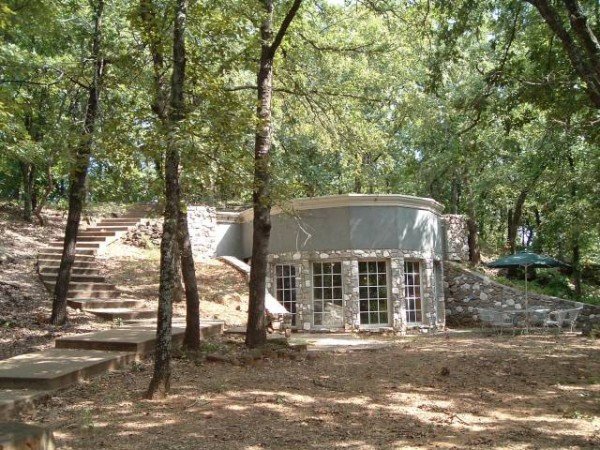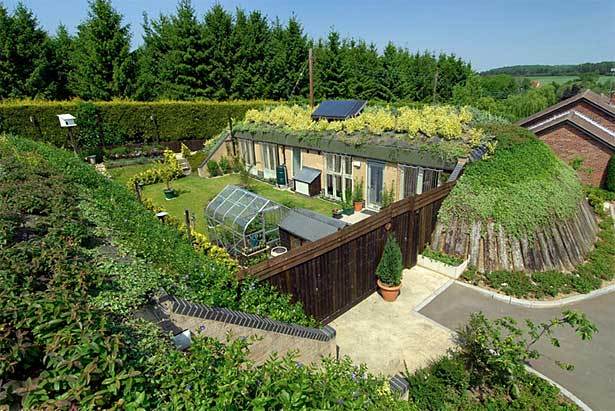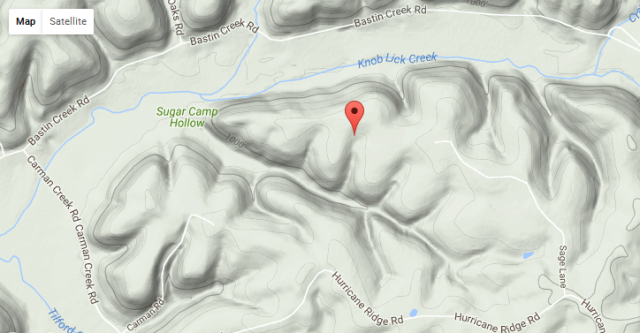I want a secure home where my family can live in peace and relative safety.
I’ve repeatedly stated that a man must be fit to rule. Once he is, he needs to develop his own kingdom. In a metaphorical sense, his kingdom can consist of many different things, but in the physical sense it begins with his castle. If you’ll notice, the castle pictured above was built to meet the stated goal above. Back then a castle was a base of operations for the local headman and was designed to offer a place of safety from wandering attackers or peasant uprisings. Because it offered a place of safety and employment, typically a village grew up nearby because the castle was a production center. Today, the threats are a bit different.
These days, what is pictured above and below are far better options. An earth-sheltered home that will stay warm in the winter and cool in the summer, which means that the cost of living there will be very low. Notice the greenhouse and solar collector for hot water above. When the power goes out in the middle of winter this would be a nice place to have. We don’t see a chimney, but for northern locations this could easily be accomplished and a small wood-burning stove will keep an earth-sheltered home toasty warm in the winter.
 You can call it a hole in the ground, but inside it’s got a lofty ceiling and lots of natural light coming in. With a good design one will never feel like they’re in a cave.
You can call it a hole in the ground, but inside it’s got a lofty ceiling and lots of natural light coming in. With a good design one will never feel like they’re in a cave.Several years ago I wrote about building underground homes using shipping containers and concrete. It’s not difficult and from the standpoint of a “do-it-yourself” deal, it works well. One of the really nice thing about using shipping containers is that much of the finishing work can be performed before they are ever put together and buried. Meaning, contractors can be used for skilled work such as electrical, plumbing or finish carpentry. You can have professionals install the kitchen. Best of all, the vast majority of work can be done off-site and when it’s ready, have the containers trucked in and buried.
There are other ways of building earth-sheltered homes, one of which (also low-cost) is the monolithic dome home. There are more traditional ways of building underground homes as well. There is one iron-clad rule that must be observed: insulate the outside of the structure before the dirt goes on using closed-cell urethane foam. Otherwise, there is a strong probability that warm, moist air during the summer will condense on the interior walls and ceiling and it will “rain” inside. Not a good situation.
In a previous post I discussed homesteading and growing ginseng. This is the sort of housing that compliments those activities, but it doesn’t matter where such a house is built. The savings and security obtained with an earth-sheltered home don’t depend on geography. The only sticking point is that when built in suburban areas, they tend to create substantial issues with zoning and regulation because they aren’t normal.
What’s So Great About An Underground Home?
First and foremost, they are secure homes. Earthquakes, tornadoes, violent storms, no problem. They’re even pretty reasonable shelter from radioactive fallout after a nuclear attack. With a bit of planning and preparation, they’re extremely resistant to an assault and can be very defensible. The nice thing about all that dirt is it’s bulletproof. Since building such a home requires moving quite a bit of dirt, there is no reason why an escape tunnel can’t be put in place when the home is built. Homes such as this need a (hidden) back door.
Second, earth-sheltered homes are excellent shelter. Cool in the summer and warm in the winter, they are liveable homes with no electricity as long as you have a supply of water. If the home is properly designed and sited, it will offer a higher quality of life than a “normal” home. The savings in energy costs can be enough to pay the mortgage.
Third, these homes are low-profile. With a bit of time and creative landscaping they are all but invisible unless you’re standing in front of them. If done correctly, they won’t be identifiable as a structure from satellite images either.
Fourth, zoning regulations and property values practically require such homes be built in rural locations and with at least 8-10 acres of land, so there is plenty of room for a large garden and livestock. A good permaculture design will ensure that not only is the home a good shelter, but the operation can provide the vast majority of the food for the family. Which means I’m talking about what is known as “homesteading”.
If your housing won’t allow you to produce a significant amount of the food your family consumes, at least 3/4 of it, then ultimately your housing isn’t sustainable in bad times. With no food and no water, it’s just a box to die in. In any number of scenarios, the power grid goes down, the supply chain breaks and the shooting and starving begins. A lot of cell towers have battery backup, which means people will be able to coordinate their mayhem in the beginning. There are not nearly enough police or national guard to deal with the problem once it starts and after that everything breaks.
Everyone has been conditioned with the idea that government can do anything. News Flash: it can’t. When things get out of hand, the violence will be happening everywhere and it won’t be containable with the “swarming” tactics used under normal conditions. With no power to pump fuel, how to the police get gas? How do they get paid? How do they feed themselves or their families? Who protects their families when they’re at work? In other words, how long will they be on the job when the violence goes out of control?
You don’t need to worry about the doom and gloom, all you really need to know is an earth sheltered (underground) home is very liveable, warm in winter, cool in summer and never needs to be painted. The cost of utilities is extremely low, they’re tornado-proof and are completely safe. If the power goes out it doesn’t matter if there’s a sub-zero winter storm outside, a small wood-burning stove will heat the home quite well. If it’s the summer-time in the middle of a heat wave, the home is still going to stay below 70 degrees inside. Either way, light a few candles or an oil lamp after dark and you’re set.
Why Don’t More People Do This?
There are a lot of reasons, but they boil down to ignorance and enslavement to public opinion. This isn’t what “normal” people do. Plenty of people will claim that the resale value won’t be good because it’s not “normal” and banks won’t want to loan the money to build one. That’s ridiculous. People will buy these things if they understand what they’re actually buying.
Underlying all that is the fact that most people don’t plan and don’t have any idea what the real threats are. There is an entire media industry that’s in business to keep the population pacified and under control. Keep everyone calm and maintain business as usual. When you consider that a homesteader lifestyle is a lot of work and it’s oriented around a different set of values than the vast majority of people have, obviously only a few would be willing to do something like that.
Even when people think about preparedness, they have the mentality that it’s something they can think about occasionally and ignore the rest of the time. It’s “emergency” preparedness, not a lifestyle. Emergencies only last for a little while and then everything goes back to normal! Consider the assumptions of the following graphic:
Notice all the assumptions? Once the 30 day supply of food is gone, where will your food come from? Same with the water. Cell phones? This assumes the cell networks will continue to function. Having gas in the vehicle is great, but what about bicycles? Driving around in an emergency does nothing but draw attention to the fact that you’re there. A multi-tool? C’mon. You’ll need a fully-stocked workshop with lots of hand tools that don’t require electricity.
The knowledge and skills necessary to be a successful homesteader can be daunting, but it isn’t rocket science and often it’s a matter of having the correct tools to do the job. Gardening is not difficult and depending on how it’s done can be efficient with a minimum of work. However, when all the produce starts coming in the pace picks up because the vegetables need to be picked, washed, processed and canned. That requires large vats to boil the water, a good supply of canning jars and lids, as well as all the rest of the equipment necessary to do the job efficiently. And let’s not forget about the labor requirements.
The Litmus Test For Appropriate Housing
Over the past few decades I have watched as time and time again the focus of preparedness has centered on weapons, ammunition and stored food instead of appropriate housing and food production capacity. There is a great deal of disagreement over this, but in keeping with the idea that one should be prepared for the worst and hope for the best, the litmus test for appropriate housing is simple:
How well does the home function without electricity for an extended period of time?
- In the middle of winter in sub-freezing temperatures?
- In the middle of summer with very high temperatures?
- With public services such as gas and water cut off?
It’s all well and good to rent a place that fails if you’re working toward getting something that will pass this test, just make sure you don’t buy something that fails this test.
Speaking of purchasing property… if you borrowed money to buy it, the property really isn’t yours until it’s paid for. After that it still isn’t really yours because if you don’t pay your rent to the State, they will take it away from you. Which means that property taxes are an issue and in some places, property taxes are quite high.
Property taxes are an expense, but they are based on the appraised value. What if the local government didn’t know your house was there? If the homesite can’t be seen from the road (you really don’t want it to be visible from the road), then it can be done. The solution is to give the local government and utilities something to see that answers the questions. The solution is to have a “hunting camp” with an electrical hookup. It could be simple:
 The beauty of a 20-foot container building like this is it can be brought in on the back of a roll-bed truck and dropped off without the need for a crane. It’s a time-consuming project, but the container can be set up on piers and leveled using hydraulic jacks. Because it’s a portable building, you get your electricity (construction hookup) without any inspections.
The beauty of a 20-foot container building like this is it can be brought in on the back of a roll-bed truck and dropped off without the need for a crane. It’s a time-consuming project, but the container can be set up on piers and leveled using hydraulic jacks. Because it’s a portable building, you get your electricity (construction hookup) without any inspections.A more robust setup can be put in place that’s designed to be a permanent fixture. This is actually an excellent idea because it provides a reason for why the entry driveway is present.
 With this design, a vehicle can be parked under the roof or the open space can be used for a common area. It wouldn’t take much to equip something like this as a hunting camp or a home to live in while building the real home. Keep in mind that the one thing you don’t see is the insulation on the outside. A few inches of sprayed-on closed-cell urethane foam is all it takes to keep them warm or cool.
With this design, a vehicle can be parked under the roof or the open space can be used for a common area. It wouldn’t take much to equip something like this as a hunting camp or a home to live in while building the real home. Keep in mind that the one thing you don’t see is the insulation on the outside. A few inches of sprayed-on closed-cell urethane foam is all it takes to keep them warm or cool.For less than $8,000 and a bit of sweat equity, something like the “hunting camp” pictured above could be built and it would be a cozy home. The containers can be purchased individually on a cash basis, as well as all other building materials. Surplus and used building materials can be used.
Location, Location, Location
The single most important factor in having a good homestead that will shelter you in times to come and allow you to not just survive, but thrive, is location.
You need to be close enough to a city to work and far enough from the city to have some privacy.
Water
More and more locations have local ordinances that require residents to be connected to the municipal water supply. In some cases having a water well is forbidden, ostensibly because it might result in a dual water supply that might result in contamination of the municipal water supply. These are places to avoid because rule #1 is to be in control of your water supply.
A good water well is the best option, although a good year-round spring or other source of water is also a good option. Many people have cisterns and utilize rainwater if the climate allows. If you have the discipline, great, but a good water well is best if the power is available to run the pump. If the well isn’t too deep a hand-pump can be installed to lift the water. There are always options.
Obtaining a water well is the first task to be accomplished with the property. Claim the purpose of the well is livestock watering if there has to be a reason given. The well needs to be close to the home and suitably protected (and hidden) such that it’s not vulnerable in case of problems. Ideally the well would be adjacent to the house and a portion of the home extended to cover the well and allow access from inside the home. And, yes, that might mean doing some interesting rigging if you ever have to pull the pump out to replace it. That’s the price of security.
Production
Ginseng farming has already been covered in a previous post and one of the points that post made was the importance of selecting the location and the property to allow doing what you want to do. There are very few properties available that have a year-round stream with a good flow and 100 feet of drop in elevation as they go through the property, but that’s exactly what you want to find to set up a hydro-electric station and have your own power plant.
Some people will be in a location that facilitates running a commercial farm and they’ll be able to make a very good living just selling food. The fact they don’t have any place to put ginseng doesn’t bother them. Others will have a day job that pays the bills and allows them sufficient time to work the homestead. There are various skills that allow working online from just about anywhere and such work provides the income to get the homestead up and running. As the homestead comes into production the cost of living drops as food and salable products are produced.
The point is that living out in the country does not mean one has to be poor. Having sufficient land to allow the production of food gives you a degree of independence not found elsewhere. So what if a bunch of SJW’s think you’re a racist misogynist. The chickens will keep laying eggs, the milking cow will still produce milk, the steers will keep grazing and growing, the hogs will keep rooting around in the compost pile, the bees will still make honey and your garden will still grow. They don’t care.
Everything you produce and consume is something you did not have to spend taxable income on. Your stored food is an asset. Your livestock and equipment are assets that will produce more.
You Castle Isn’t Just A Home, It’s A Production Center
A center of production requires space, tools and energy. Burying a couple of 1000 gallon propane tanks means you can keep years worth of propane on hand for cooking and hot water. A couple of large fuel tanks will provide your own (limited) supply of gasoline and diesel fuel and there are additives that allow fuel to be stored for years. A well-stocked maintenance barn with a good lift means you can do a lot of repairs and maintain your vehicles and equipment. These are normal things to find on a farm but they cost money.
Setting up a complete off-the-grid electrical system is expensive. Huge solar panel arrays, battery banks, inverters, filters and a gas-powered generator (with more buried propane tanks) will mean you have electricity if the power goes out and be able to go on with your life. Like everything else, such a system costs a lot of money and requires knowledge and experience to maintain it. Call it a learning experience. A hydro-electric setup is the holy grail of off-the-grid living because if you have a year-round stream that will run a hydro plant, you are your own power company.
A decent metal shop with welders, a lathe, milling machine, some saws and an ironworker will allow you to fabricate just about anything if you have a good supply of steel bar, tube and sheet stock. A decent woodworking shop with a good tablesaw, jointer, planer and a few specialty tools on the back end and a bandsaw mill and small kiln dryer on the front end will allow you to harvest your own trees and turn them into anything from lumber to furniture. And, yes, these kinds of tools use a lot of electricity. Which means the best time to run them is on bright, sunny days in the summer when your electric production is at it’s peak.
When spare time is available, use the tools to make the place pretty.
A good backhoe and dump truck, combined with a skid-steer and a few attachments will allow you to do a lot of work around the farm. There are excellent hydraulic concrete mixer attachments available for skid-steers that allow you to mix small batches of concrete quickly. Something like this 1/3 yard concrete mixer.
A roadheader attachment for the backhoe will allow you to do amazing things. They go through stumps like a hot knife through butter but they really shine when it comes to creating swales and terracing across slopes. A small bulldozer will allow you to maintain your own roads and do some creative earth-moving. Adding an old crane with a 20 ton capacity will allow you to finish, manipulate, install and bury buildings made from shipping containers, anywhere you want, with privacy.
Housing can be built at a low cost so putting in some housing for occasional farm labor and visitors is called for. But other buildings are needed as well. Barns for storing hay, storing machinery, shops for doing maintenance and work, there are a lot of reasons to build other farm buildings.
I bet the hogs would like an earth-sheltered farrowing-barn that stays warm in winter and cool in summer, don’t you? With plenty of storage space for feed? What about the cows? Wouldn’t they like a comfortable barn that’s easy to clean, sanitary for milking and comfortable? Less stress on the animals means more production from the animals and the buildings are cheap. Especially if you have the time and equipment to build them.
All of these things require knowledge, skill and experience. They are tools that allow you to do things and as far as homeschooling your children they all require skills that are useful to learn. But, we’re in the 21st Century, right? So add 3D printing capability and computer-controlled machining to all that. There’s no reason not to get into robotics and drones. Who says homeschooling can’t be fun?
While the homestead can produce the kind of income to support this, one might still wonder, why buy all this stuff? First, it’s extremely handy to have around when you want to get something done. Second, we’re talking about the tooling and equipment for multiple different businesses your children can learn and the equipment can earn money. These are businesses that have deductions for expenses and they can lose money for tax purposes, which means allocating money across the various businesses can result in no taxes. If one considers that “self-employed” income of $60,000 per year will require $9,300 in FICA taxes along with another $10,700 in federal taxes, you’re looking at the government taking 1/3 of your income in taxes.
The secret to avoiding that is to have lots and lots of allowable deductions that cover the money you would have spent anyway. There is no need to receive money, pay taxes on it and then spend it on something that would have been a tax-deductible expense if the company had spent the money. It’s all a matter of organization.
One of the major reasons to not say anything about growing ginseng is there are lots of ginseng buyers out there and they pay cash and don’t file a 1099 form with the IRS. Taking prime ginseng root to various buyers would mean having completely off-the-books income in cash money. On a homestead where expenses are very low, selling 30 pounds of ginseng for cash is the equivalent of selling 44 pounds “officially” and sending the government $14k in taxes. This is the truth of being “self employed” in America:
 I don’t advocate tax evasion, but tax avoidance is perfectly legal. A lot of the very useful equipment listed above is what is know as business equipment. Organize it as a business and claim the allowable deductions such as depreciation, maintenance, repairs and operating costs. If you were going to pull out $60k in ginseng every year, why not use the money you would have been sending to the government to obtain and maintain the things you want to have? Seems to be perfectly logical and it’s legal.
I don’t advocate tax evasion, but tax avoidance is perfectly legal. A lot of the very useful equipment listed above is what is know as business equipment. Organize it as a business and claim the allowable deductions such as depreciation, maintenance, repairs and operating costs. If you were going to pull out $60k in ginseng every year, why not use the money you would have been sending to the government to obtain and maintain the things you want to have? Seems to be perfectly logical and it’s legal.Make A Master Plan Before You Make Mistakes
An old farmer once observed to me that “Every permanent fence I ever built got torn down and every temporary fence I built is still there. Life is strange.”
What he was describing was a lack of a plan, but it’s more complicated than that. It takes time to fully understand a piece of land and the vast majority don’t have any idea of what is possible. No, that’s not me trying to sell consulting services.
What can and should be done is draw up a site plan. The terrain and layout will dictate a lot of how things will need to be placed, but care should be given. This is why I recommend that a young man live on his farm for a few years before building his permanent house. As he gets to know the land and works to develop it, he will gain an understanding of what could be and what can’t be. This is an example by Bill Mollison:
 This is a drawing of a permaculture setup that has the various production areas arranged in zones based on how often you need to visit each zone. The more often it needs to be visited, the closer to the home it should be.
This is a drawing of a permaculture setup that has the various production areas arranged in zones based on how often you need to visit each zone. The more often it needs to be visited, the closer to the home it should be.The plan should take into account where your access roads and trails are, where your buildings will be to support your other activity and where different production units will be based. You might have one pasture that’s for grazing cows and chickens, another pasture that’s strictly for hay. One area for the house and garden areas, with a chicken house for egg layers and a greenhouse close by. Or perhaps you combine them. The plan should take into account drainage of water and show your water and septic lines.
Fences and where your fences go is another important consideration. Areas for immediate development and future development should be marked off. If water is an issue then you’ll want a water tower placed where it’s at the highest point to get the maximum head pressure from gravity.
Because ginseng takes so long to grow, if a major effort is put in initially to get seed in the ground then there will be a period of four to five years for plans to be developed. More ginseng can be planted and work can be done, but by the time the ginseng would be at the point to yield any money there is plenty of time to determine how it can best be used. Focus on infrastructure and get perimeter fencing and water production and distribution lines in place. Get pastures cleared and the soil prepared. These things don’t necessarily cost a lot of money but they do take time.
One of the main ways to occupy your time in the early years is with education. There are dozens of books to read and if you plan on doing a lot of the work to build your structures, you’ll possibly need to get some instruction and develop some skill in order to do so. Part of the plan is to figure out what needs to be done in what order to make the process efficient.
The ancient castles were originally sited based on the terrain and access to water. They started off as wooden palisades and over the generations they grew and changed. This is much the same process but it will happen a lot faster. Keep in mind that this will be your kingdom so make sure it’s orderly. That requires a plan.
























